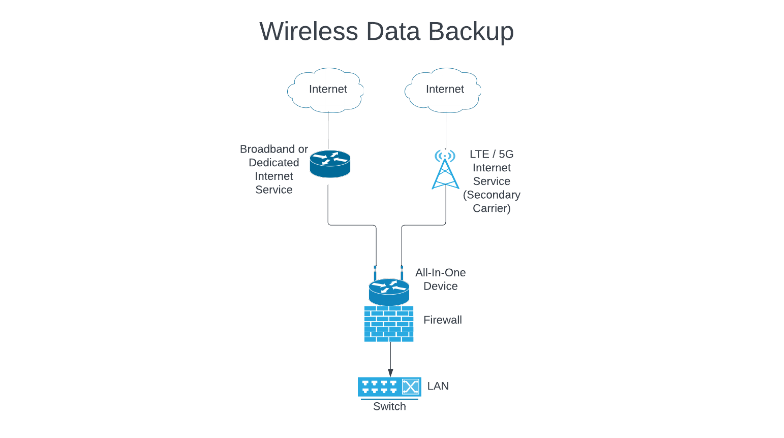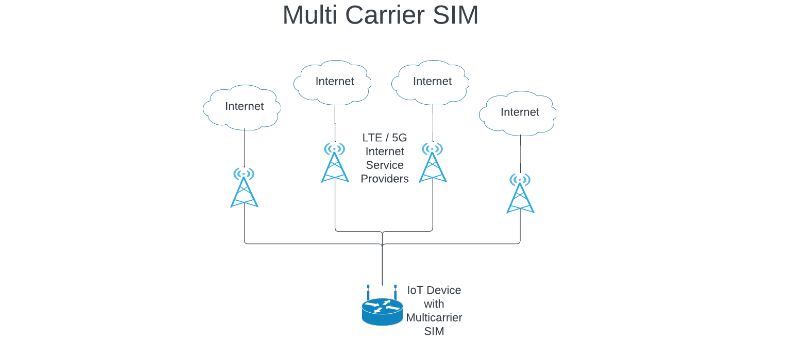Multi Carrier SIM Cards vs. Standard Carrier SIM Cards: Pros and Cons
In this post, we'll discuss the SIM card, its role in your business network, and how it's evolved to meet changing needs and the rise of IoT

Jun 15, 2023
SHARE
They seem to get smaller every year…but that doesn’t mean they’re less important. Let’s take a fresh look at the humble SIM card, their role in your business network, and how they’ve evolved to meet changing needs and the rise of the Internet of Things (IoT).
What Is a SIM Card?
The Subscriber Identification Module, or SIM card, is a tiny piece of plastic, with an equally minute electrical component embedded on its surface. It’s a familiar piece of technology to anyone who’s ever bought a cellphone.
You can’t operate your cellphone (or many other electronic devices, including smart watches, cameras, and trackers) without a valid SIM card. They come in a few different shapes and sizes – there’s also a newer iteration, known as an eSIM. This is still a physical component, but it’s much smaller and hardwired to the motherboard of your device. The information on an eSIM is rewritable, though, so you access and activate it via a software download.
What does a SIM card do? Let’s keep it simple and say a SIM card has three primary functions.
It establishes communications with the relevant wireless service provider.
It identifies the subscriber’s identity.
It provides an encrypted passkey.
So, what are the types of SIM and what kind of deployment suits your business needs? We’ll start by looking at the standard plan, single-carrier SIM card.
Standard Carrier SIM Plans and Topologies
Standard SIMs are a familiar concept for most people – they’re locked to one network and carrier, such as AT&T, Verizon, or T-Mobile, and they can’t be switched.
You can, however, deploy them alongside SIM cards from different carriers, using wireless (LTE/5G) routers and modems designed to carry two SIMs at the same time.

This gives you an additional element of diversity in your network set-up.
For mobile network environments, a typical dual SIM set-up would use one SIM and provider as the primary network, with the second SIM providing secondary network functionality.
This works well for mobile networks working within a limited geographical area. If your wireless wide area network (WAN) needs to go countrywide, over multiple states or even time zones, you might need to find a different solution – over larger areas, mobile providers can have overlapping dark zones, and there’s very little router equipment on the market with the capability to run three or more SIMs.
A dual SIM configuration can also be used in a stationary installation – if your primary network fails, a dual SIM router can quickly switch to the other SIM and provider (assuming their network is still operational).
If you’re staying in one location, though, you might consider a “wireless data backup” style topology instead.
This topology is mostly deployed at small branch sites with a primary broadband connection and no options for a diverse secondary circuit (for example, at locations where there isn’t another carrier that can provide connections along a separate physical route).
Businesses designing a network in this way should ensure they create proper prioritization protocols so that any wireless usage is minimized and restricted to only the most critical business functions, limiting network congestion.
But what’s the relative cost of this kind of wireless deployment at an enterprise level? These topologies are usually tied to a set data plan, with either prohibitive costs for overage, or throughput inhibitors that’ll slow your data to a crawl.
Estimating your bandwidth requirements is always a challenge, even for seasoned network engineers. In our (near) infinite wisdom, we usually advise customers to err on the lower side when procuring connectivity – for the simple reason that it’s much easier to negotiate an increase in service level with your provider than a decrease.
There are some good deals around for wireless WAN packages with near-enough “all-you-can-eat” bandwidth, but with scalable throughput inhibitors that you can reset once you’ve thoroughly assessed your needs.
Multi Carrier SIM Plans and Topologies

A relatively new development, multi-carrier SIMs have come into their own with the advent of the IoT. As an ever-greater variety of equipment, both mobile and stationary, now requires connectivity, ensuring a stable connection regardless of location is a must.
Connected devices like fleet trackers are a good example of where multi-carrier SIMs are the only real solution – long-haul international transportation tracking is made infinitely easier by a SIM that can switch networks at will.
There are two main types of multi-carrier SIM – steered and unsteered.
Steered SIMs will default to a primary carrier, only switching networks when the primary is unavailable. Unsteered multi-carrier SIMs work by continually checking for the strongest available carrier and changing connection when a higher-performing network is nearer.
Multi-carrier SIMs also provide any function you’d associate with a standard carrier SIM. The only real disadvantage is financial – multi-carrier SIM services require a middleman, or aggregator, to collect and process usage billing data from multiple carriers, to present the enterprise customer with a single bill. This inevitably leads to an additional service cost.
Navigating this space can be challenging, and there’s no one right answer – there is some complex geographical and usage calculations needed to work out your ideal wireless topology. You can save time and money using the Lightyear Telecom Procurement Platform to automate most of your calculations, and our team of experienced telecom professionals can take you the rest of the way.
Want to learn more about how Lightyear can help you?
Let us show you the product and discuss specifics on how it might be helpful.
Not ready to buy?
Stay up to date on our product, straight to your inbox every month.
